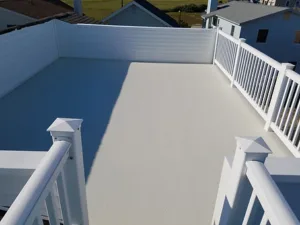Decks add both aesthetic and functional value to homes, providing a perfect space for relaxation and entertainment. However, choosing the right decking material can be a daunting task, with solid fiberglass and wood being two popular options. This comprehensive comparison will delve into the pros and cons of each, focusing on key factors like durability, maintenance, aesthetic appeal, and cost-effectiveness, to guide homeowners in making the best choice for their outdoor living spaces.

solid fiberglass deck
Understanding Solid Fiberglass Decks
Composition and Manufacturing Process
Solid fiberglass decks are crafted from a blend of fiberglass and resin, offering a durable and waterproof surface. This combination undergoes a meticulous manufacturing process, ensuring a uniform and sturdy finish that stands up to various environmental conditions.
Benefits of Solid Fiberglass Decks
These decks are celebrated for their exceptional durability and low maintenance needs. They resist moisture, decay, and pest damage, making them ideal for areas prone to harsh weather conditions. Furthermore, their non-porous surface prevents staining and fading, maintaining their aesthetic appeal over time.
Potential Drawbacks
Despite their advantages, solid fiberglass decks may present limitations in customization and initial cost. Their selection of colors and textures is not as vast as that of wood decks, and they generally require a higher upfront investment.
Exploring Wood Decks
Types of Wood Used for Decks
Wood decks are typically made from a variety of materials, including pressure-treated lumber, cedar, redwood, and tropical hardwoods. Each type offers unique characteristics, from natural resistance to decay to distinct color variations.
Advantages of Choosing Wood Decks
Wood decks bring a natural warmth and beauty to outdoor spaces that is difficult to replicate. They offer a wide range of customization options, from stains to finishes, allowing for unique designs. Additionally, wood decks can be more cost-effective initially compared to solid fiberglass.
Limitations and Maintenance
The major drawback of wood decks is their need for regular maintenance, including staining, sealing, and protection against moisture and pests. Over time, wood can warp, crack, or rot if not properly cared for.
Durability and Maintenance: A Side-by-Side Analysis
Comparing Lifespan and Durability
Solid fiberglass decks often outperform wood in terms of durability and lifespan, requiring less maintenance to retain their condition. Wood decks, while durable with proper care, may not withstand the elements as effectively over time.
Maintenance Needs and Ease of Repair
Fiberglass decks need occasional cleaning with mild soap and water, whereas wood decks require frequent staining and sealing. When damage occurs, wood decks can be easier to repair than fiberglass, which may need professional attention for significant issues.
Aesthetic Appeal and Customization Options
Visual Comparison
Wood decks offer a timeless, natural look that many homeowners desire. Fiberglass decks, though limited in appearance options, provide a sleek, modern finish that suits contemporary homes.
Customization and Design Flexibility
Wood decks excel in design flexibility, accommodating various styles and preferences. Fiberglass decks, while improving in customization options, still lag behind in the variety of textures and colors available.
Environmental Impact and Sustainability
Eco-Friendliness of Materials
Wood decks, especially those made from sustainably sourced or reclaimed wood, are often viewed as more environmentally friendly. Fiberglass decks, on the other hand, are made from non-renewable resources but offer longevity that can be considered environmentally beneficial in the long run.
Recyclability and Environmental Footprint
Both deck types have their challenges in terms of recyclability and environmental impact. Wood decks may contribute to deforestation if not sourced responsibly, whereas fiberglass decks are not easily recycled and can have a larger carbon footprint due to their manufacturing process.
Cost Analysis: Initial Investment vs. Long-Term Value
Upfront Costs
Wood decks typically have lower initial costs compared to solid fiberglass decks. However, the price can vary significantly based on the type of wood chosen.
Long-Term Expenses and Value
Although fiberglass decks have a higher upfront cost, their minimal maintenance requirements and longer lifespan may offer better long-term value. Wood decks, while cheaper initially, may incur higher maintenance and replacement costs over time.
Installation Process and Time
Ease of Installation
Wood decks are generally easier and quicker to install than fiberglass decks, which may require specialized tools and expertise for proper installation.
Time Required for Installation
The installation time for wood decks can vary based on complexity and design, but they are typically faster to construct than fiberglass decks, which need careful handling and curing.
Solid Fiberglass vs. Wood Decks
Choosing between solid fiberglass and wood decks depends on several factors, including budget, maintenance preferences, aesthetic desires, and environmental considerations. Both materials offer unique benefits and drawbacks, making it essential for homeowners to weigh these aspects carefully.
FAQs
Which deck type is more resistant to weathering? How do maintenance requirements compare? Can either deck type be considered eco-friendly? Which deck offers better long-term value? How do the aesthetic options differ between the two? Are there any significant differences in installation time?
Conclusion
Solid fiberglass and wood decks each have their place in outdoor living spaces, with the choice ultimately depending on individual needs and preferences. By considering factors like durability, maintenance, aesthetics, and cost, homeowners can select the decking material that best suits their lifestyle and enhances their home’s value and appeal.




























